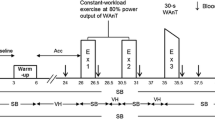Summary
Investigations in our laboratory have shown an increased slope of the ventilatory response curve to CO2 (CO2 sensitivity) during positive and negative exercise as compared with the resting condition. CO2 sensitivity during positive and negative exercise did not differ in spite of differences in metabolism (\(\dot V\)O2, \(\dot V\)CO2) and type of muscle contraction (concentric or eccentric).
Various aspects of positive and negative exercise were examined in order to find out whether they can explain the identical CO2 sensitivity. Cardiac output, oxygen consumption, rectal temperature and venous catecholamine concentration appeared to be higher in positive exercise than in negative exercise, and higher in negative exercise than at rest.
However, these differences between the two types of exercise contrast with the identical CO2 sensitivity and thus cannot be of major importance in determining CO2 sensitivity. It is hypothesized that one or more of these variables might be responsible for increased CO2 sensitivity during exercise as compared with rest. The CO2 sensitivity, once increased, seems to be unaffected by further increases in these variables.
Similar content being viewed by others
References
Asmussen E, Nielsen M (1956) Physiological dead space and alveolar gas pressures at rest and during muscular exercise. Acta Physiol Scand 38: 1–21
Collier CR (1956) Determination of mixed venous CO2-tensions by rebreathing. J Appl Physiol 9: 25–29
Cotes JE (1955) The role of body temperature in controlling ventilation during exercise in one normal subject breathing oxygen. J Physiol 129: 554–563
Cunningham DJC, O'Riordan JLH (1957) The effect of a rise in the temperature of the body on the respiratory response to carbon dioxide at rest. Q J Exp Physiol 42: 329–345
Cunningham DJC, Hey EN, Lloyd BB (1958) The effect of intravenous infusion of noradrenaline on the respiratory response to carbon dioxide in man. Q J Exp Physiol 43: 394–399
Cunningham DJC, Lloyd BB, Patrick JM (1963) The relation between ventilation and end-tidal PCO2 in man during moderate exercise with and without CO2-inhalation. J Physiol 169: 104–106
Ekelund L-G (1967) Circulatory and respiratory adaptation during prolonged exercise. Acta Physiol Scand [Suppl] 70: 292
Herwaarden CLA van, Binkhorst RA, Fennis JFM, Laar A van't (1980) Reliability of the cardiac output measurement with the indirect Fick-principle for CO2 during exercise. Pflügers Arch 385: 21–23
Jones NL, McHardy GJR, Naimark A, Campbell EJM (1966) Physiological dead space and alveolar-arterial gas pressure differences during exercise. Clin Sci 31: 19–29
Jones NL, Campbell EJM, Edwards RHT, Wilkoff WG (1969) Alveolar-to-blood PCO2 difference during rebreathing in exercise. J Appl Physiol 27: 356–360
Jones NL, Robertson DG, Kane JW, Campbell EJM (1972) Effect of PCO2 level on alveolar-arterial PCO2 difference during rebreathing. J Appl Physiol 32: 782–787
Kesseler K (1966) über die arterielle CO2-Spannung und die arteriell-endexspiratorische CO2-Spannungsdifferenz wÄhrend körperlicher Arbeit. Int Z Angew Physiol Einschl Arbeit-sphysiol 23: 140–158
Klausen K, Knuttgen HG (1971) Effect of training on oxygen consumption in negative muscular work. Acta Physiol Scand 83: 319–323
Mason JW, Hartley LH, Kotchen TA, Mougey EH, Ricketts PT, Jones LG (1973) Plasma cortisol and norepinephrine responses in anticipation of muscular exercise. Psychosom Med 35: 406–414
Miyamura M, Folgering HTh, Binkhorst RA, Smolders FDJ, Kreuzer F (1976) Ventilatory response to CO2 at rest and during positive and negative work in normoxia and hyperoxia. Pflügers Arch 364: 7–15
Nielsen B (1966) Regulation of body temperature and heat dissipation at different levels of energy- and heat production in man. Acta Physiol Scand 68: 215–227
Nielsen B (1969) Thermoregulation in rest and exercise. Acta Physiol Scand [Suppl] 323: 1–74
Peuler JD, Johnson GA (1977) Simultaneous single isotope radio-enzymatic assay of plasma norepinephrine, epinephrine and dopamine. Life Sci 21: 625–636
Planz G, Gierlichs HW, Hawlina A, Planz R, Stephany W, Rahn KH (1976) A comparison of catecholamine concentrations and dopamine-Β-hydroxylase activities in plasma from normotensive subjects and from patients with essential hypertension at rest and during exercise. Klin Wochenschr 54: 561–565
Smolders FDJ, Folgering HTh, Bernards JA (1977) Capnostat and oxystat. Electronic devices to automatically maintain the end-tidal PCO2 and PO2 of a subject connected to a closed respiratory circuit at adjustable levels. Pflügers Arch 372: 289–290
Stegemann J (1977) Arbeitseinflüsse auf die CO2-Antwortkurve. In: Stegemann J (Hrsg). Leistungsphysiologie, 2. Auflage. Thieme, Stuttgart, pp 181–183
Thomson DA (1971) Cardiac output during positive and negative work. Scand J Clin Lab Invest 27: 193–200
Weil JV, Byrne-Quinn E, Sodal IE, Kline JS, McCullough RE, Filley GF (1972) Augmentation of chemosensitivity during mild exercise in normal man. J Appl Physiol 33: 813–819
Whipp BJ, Wasserman K (1969) Alveolar-arterial gas tension differences during graded exercise. J Appl Physiol 27: 361–365
Zeidifard E, Silverman M, Godfrey S (1972) Reproducibility of indirect (CO2) Fick method for calculation of cardiac output. J Appl Physiol 33: 141–143
Author information
Authors and Affiliations
Rights and permissions
About this article
Cite this article
Hulsbosch, M.A.M., Binkhorst, R.A. & Folgering, H.T. Effects of positive and negative exercise on ventilatory CO2 sensitivity. Europ. J. Appl. Physiol. 47, 73–81 (1981). https://doi.org/10.1007/BF00422485
Accepted:
Issue Date:
DOI: https://doi.org/10.1007/BF00422485




